2: Still Collecting Playing Cards at 80
This is a personal account of some of my experiences collecting playing cards.
This is a personal account of some of my experiences collecting playing cards: you can only blame me for the content!
At one time I was one of the younger members of IPCS, but that was a long time ago. Of course, I've not yet reached the giddy heights of Mike Goodall or Michael Copeman, still collecting cards and background information into their nineties, but I feel grateful that I've lasted as long as this. Some time about 78 years ago, I set off on my long journey into the world of playing cards. Towards the end of WWII my father gave me a (very grubby) pack of Waddington’s playing cards advertising Wills Woodbine cigarettes (he didn’t smoke), and I can remember sitting in my pram admiring them, indeed falling in love with them! The QC was my favourite. So, as you may guess, as this was so early in my childhood, I can’t say exactly when it was. The pack did not survive the vicissitudes of being owned by a small child, who hadn’t learnt proper motor skills, and was eventually thrown away, even though at one stage I tried to hand-draw the missing cards to make it complete again. So that this story doesn’t become just a boring historical catalogue (it may be, anyway, to some), I thought it would be best, if I illustrated it with a few examples of the cards that fascinated me. This first acquisition no longer exists, but it is commonplace and I have a replacement full pack of the same sort.

Above: Waddington for Woodbines, c.1943

The next incident I recall is from 1946. While staying with one of my uncles in Devon I was given a pack of De La Rue Crown cards to keep me quiet. This was a common occurrence on our visits to family and friends, and I often ended up adding the prize to my collection. On this occasion we were woken in the night by my uncle, who told us he thought the house was on fire. It was. An electrical fault in a standard lamp in the living room had set the wall alight. The fire brigade put out the fire very smartly and we all went back to bed, though I don’t remember the details of that. What I do remember is getting up the next morning and asking if the cards were all right! This was clearly my one concern. They were, in fact, and accompanied me home when the holiday was over.
In case anyone doubts my early commitment to playing cards, here is a picture of me about the age of 5 dressed up as a pack of cards. Two packs of miniature cards with spotty dogs on the back and copies of Universal courts (I still don't know who made them!) were sown front and back onto a tabard made of black-out material, and I held a wand with a Waddington joker attached to the top. Eight aces and two jokers were sown round the rim of my cap. And there I was - a pack of cards! And I won first prize in the fancy dress competition! And I still have the cards, carefully unpicked from the tabard.
So, my early acquisitions were standard English packs, either contemporary or from the 1930s, by the main makers of the day: Waddington No 1, De La Rue Crown, Goodall Federation and New Bond by Universal for Woolworth with Native American silhouettes on the backs. Here's an example of a pack I got from an aunt, which dates to the early 1930s, with an interesting Art Deco back design.

Above: De La Rue, c.1930
But very early on I came across more exotic items. Another aunt, who had retired from teaching and run an antique shop in Scarborough, finally retired from that too, and moved to the Cheshire/Derbyshire border near us. With her she brought what must have been the remains of her stock: interesting old books about foreign lands and history, a collection of fans, some nice bits of furniture, and, in particular, a Victorian Chinese pagoda made of light wood, probably bamboo, and straw work. It stood about five feet high on delicate legs and was full of little cupboards and drawers. Inside the drawers, alongside many other intriguing items (to a five-year-old, anyway), were old playing cards. Packs with swastikas on (as a good luck charm) for Kendal Milne of Manchester, non-standard patience packs by Brepols, and – joy of joys! – two single-figure packs by Reynolds.

Above: Brepols patience, c.1930
Above: Reynolds, c.1840
One of the Reynolds packs I was given when I was about 11 years old; the other had disappeared, when we cleared her cottage, after she had gone into a nursing home. So quite early on, I met with some rather different cards from the ones I had collected so far.
In the early 1950s with the lifting of the war-time and post-war restrictions on printing and paper use, other types of pack started to appear. The pre-war circular cards by Waddington reappeared, along with three other shapes: Kon-Vex, Zulu Shield and Slimline. They were all introduced c.1952: the convex cards were used in the special set for the Coronation of 1953.

Above: Waddington Kon-Vex, 1950s. These courts are the only example of a turned set of Waddington's own design.

Above: Waddington Zulu Shield, 1950s. Notice that the courts are those still found in patience packs of the time (pre-war W2 design), but the indices are of the De La Rue pattern.
This was also the period when canasta was introduced to Britain and in 1952 my parents were given their first set of two packs, by De La Rue, but with Goodall ASs and bicycle wheel backs. It’s always useful to have dating evidence of this kind: the Goodall AS was finally given up in c.1956, probably to coincide with the redesigned De La Rue AS for 1957, the 125th anniversary of the firm’s foundation.
The 1950s saw the introduction of another sort of pack, the non-standard kind. In particular, Benno Products imported Piatnik cards, the standard English type with the pretty backs and plastic finish, and a string of non-standard ones, for example The Wars of the Roses.

Above: Piatnik The Wars of the Roses, c.1955
These non-standard packs were produced for many years (some are probably still available), though whether they ever found favour with serious card-players is debatable.
Britain was never too keen on non-standard packs and produced far fewer than Continental Europe. Two examples from around this period show very little imagination in this department. De La Rue celebrated their 125th anniversary in 1957 with a pack specially designed by Jean Picart le Doux. I bought three double boxes from a stationers in Leeds in 1968, so they didn’t exactly fly off the shelves. The other was also by De La Rue for the tercentenary of the Restoration of Charles II – not to my taste at all. (I’m not sure why that particular historical event was chosen.)

Above: De La Rue: Jean Picart le Doux (top), 1957; The Lion & the Unicorn (bottom), 1960
So I started collecting all kinds of cards, including card games like Belisha, Speed and Kan-U-Go. I still enjoy playing the pre-war game Mainline by Waddy. And I found the backs interesting, too. I would save up pocket money and birthday money and go searching for goodies in the Manchester stores, especially Wiles in Lewis’s Arcade and John Heywood, the stationers on Deansgate.
As regards playing with cards, this was also something I did from a very young age. As one of ten (plus two parents), my father had also played cards from an early age, and he taught me a lot of games that are now rather out of fashion: bézique, piquet, cribbage, casino, hearts, pontoon, rummy, solo whist, as well as ordinary whist and bridge. In the early 1950s canasta was added to the list.
During the 1960s I designed one or two court sets, but got no further than the initial sketches. The cost of production, which the originator had to find, was prohibitive. One set was based on the English pattern, one on figures from the French regionals, and one was a combination of the English and Paris patterns, one at each end. And that was the end of my artistic efforts except for my own amusement!

Above: The hearts and spades from the set based on French regional figures; the figures of each suit face the same way.
My father also collected stamps and got me interested in them, too. It was this that got me into looking for small plate details and errors in the stamps, a technique that I later transferred to playing cards.
Until about 1966 I had no idea anyone else was remotely interested in playing cards, let alone collected them. Then I came across Sylvia Mann’s first book on the subject, Collecting playing cards, one of a series of Arco books for collectors. I had already acquired the reprint of Gurney Benham’s book in c.1958, but it wasn’t aimed specifically at collectors. When I eventually wrote to Sylvia, I discovered a small network of other similarly interested individuals who were keen to exchange information and packs of cards. One important figure in this group was Maurice Collett, who ran a sales list of modern playing cards at very reasonable prices – and it was even possible to buy just one pack out of a double-boxed set. At the time most collectors didn’t want two of the same item. Others I came into contact with very early on were Trevor Denning, Michael Dummett, Michael Copeman, Eddie Cass, Peter Gowans, Detlef Hoffmann, Boris Mandrovsky, David Swede, Henry Morgan, Isobel Cordwener, Evelyn Goshawk, Han Janssen and Olive Field.
Communication between us was by letter, and little bits of information were shared by those who kept in touch. But publications on the subject, especially reliable ones, were very few and far between. Die Spielkarte, produced and edited by Franz Braun, was one such.

Above: Volume 4, Number 1, 1967
Le Jolly Joker was edited by Alain Borveau with a similar content, but in a cheaper format.

Above: August-October, 1970
In 1968 Trevor Denning proposed a one-off publication for interested collectors, produced on an amateur basis. It contained articles by Albert Dickson (who sadly died not long afterwards), Trevor himself, Brian Tucknutt on card-games, Sylvia and yours truly. It appeared in 1969 as Ace of Spades. Its aim was “to provide at least a temporary link between collectors and students of playing cards and to facilitate the exchange of information and material connected with the subject.” After the various articles there was a Wants section, an Exchange section and finally Trevor’s list for the “disposal of miscellaneous playing-cards in small lots at cost.” These were items from a small collection he had bought, but he only wanted a few of the items himself. So that others could benefit from this purchase, he sold the remainder (AT COST!) via Ace of Spades. To give a little flavour of those early days I've reproduced one page of Trevor's sales list - so look at the prices - and a page of collectors' wants, so you can see some of their names.

Above: [For those unused to our old money, 40s = £2; 20s = £1; 12/6d = 62½p; 10s = 50p.]

Above: [Eddie Cass; Evelyn Goshawk; David Temperley; C.R. Williams; Trevor Denning; Brian Tucknutt; Stanley House.]
Clearly momentum was gathering for a more regular and formal method of communication between collectors and by 1972 it had gathered enough for an international society to be formed: The Playing-card Society. (The adjective international was added later.) Following on from the successful meeting of collectors in Kendal organized by Maurice Collett, I organized a further get-together at the University of East Anglia, Norwich, where I worked, in 1972. There was even a selection of cards from the local Strangers’ Hall Museum on display (see page 27).
At around this time in the University’s School of Fine Arts and Music I was getting slides made of playing cards for lectures on the topic that I gave from time to time. The cards were from my own collection, from the Strangers’ Hall Museum and from Sylvia Mann’s collection. She was generous and kind enough to lend me several albums of standard patterns from England and the rest of Europe, so that I could photograph them. These I have now been able to share with others, thanks to the digitizing process. (See page 11.) I was very grateful for that generosity.

Above: A pack by Turnbull, c.1830, from Sylvia Mann's collection
One thing that hovered in the back of my mind with the establishment of a recognizable group was that it would be open to monetary speculation. Quite a number of us at the outset were keen not to let some kind of phoney market get involved and send prices up. This is why Trevor Denning only wanted to cover his costs when he sold off the packs he didn’t want from the collection he bought. But towards the end of the 1970s Stanley Gibbons turned up on the scene, pretending they were not about to go into the playing card market. But they did. In some way or another that is not obvious to the outside observer they managed to make a mess of their business and cut back their activities ending up for the most part selling stamps again. One thing they did, of course, was bring a lot more packs onto the market, which might have taken a long time to get through to collectors otherwise. One large collection they bought was that of Kurzrock, an American collector, who had visited Turnhout at the time of the establishment of Carta Mundi, and relieved the constituent makers of their old, obsolete stock. In the Kurzrock collection there were thousands and thousands of packs and a similar number of sample cards from the Belgian makers. Examples still appear on offer on eBay, often misrepresented, in particular as regards dating, and overpriced. Anyway, it’s an ill wind, etc…
On the other hand, my worry was that because of big business intervention the hobby would turn into the preserve of well-off, old men (and a few women), which is essentially what has happened, so even rather ordinary cards are now offered for silly money. People are often unaware of the commonplace nature of many of the packs that are offered these days. It’s not that I’m ignoring inflation: a pack that cost £2.50 in 1972 would fetch between £25 and £30 depending on which inflation metric is used. This is about right for a square-cornered, indexless pack by De La Rue or Goodall of c.1875, like the ones pictured below. In fact, watching such items on eBay, I get the impression that you can get one for less than £25, if you don’t mind bézique packs or plain backs. If people want to pay more for fancy backs, that’s another issue.

Above: De La Rue D6, c.1875
Card collecting is like collecting stamps: it’s a vast area and in the end you need to specialize eventually, unless you are a hoarder. I don’t see the point of having a collection of 50,000 packs of playing cards (or anything else, for that matter – CDs, DVDs, Ming dynasty objects), because how can one appreciate such vast quantities, let alone look at them on a regular basis? So eventually I decided to concentrate on patterns derived from the French regional patterns, which included the standard English pattern – always my preferred focus. An example of a French-derived pattern of the sort that interested me is illustrated below.

Above: Piatnik’s Austrian pattern B, based on a Lyonnais pattern
After a few years I decided to be even more restrictive and collected only standard English cards from then on, returning to the origins of my fascination with the subject. I had already been working on a system of classifying the many different versions of the pattern. My first publication, besides a few articles in the IPCS Journal, was the embryo of my later book. The first version was hand produced by Roneo and appeared in 1983. It was cumbersome, with full-size photocopy illustrations, but it served its purpose. A better version with an ISBN appeared in 1991. Unfortunately, it was just before I got my first computer, so it, too, was somewhat crude with typed text and cut-and-glued, black and white illustrations of a reduced size. It was then printed and bound at the University's Print Room. As more and more information and new designs came to my attention, I really wanted to update it, but my professional work stopped me from converting the whole thing to a computerized version. So, in 2003, I reprinted the 1991 edition with an addendum of a number of extra packs as a separate section at the front. It was only in 2010, after I had retired, that I could concentrate on producing a completely revised and enlarged version (which I refer to as the second edition - the 1983 effort hardly counted!), the details of which are given on my Home Page.
My interest in the IPCS waned, as I felt the whole thing was becoming too commercialized, so I left sometime during the 1980s, though I did organize a British Group meeting at the Assembly House in Norwich in 1987 along with another, slightly larger display of cards at the Strangers’ Hall for the occasion. I still have good contacts with friends who collect cards and have benefitted hugely from knowing them, seeing their cards, exchanging information and so on. I have always been in favour of sharing information and letting other people see the cards one is privileged and lucky enough to own. Long may that continue. I have also made new contacts through this blog, for which I am grateful. Sadly, most of the people who started out on this interesting and inspiring journey are no longer with us or have disappeared from the scene, but their place has been taken by others. I would particularly like to mention Mike Goodall, Donald Welsh, Rex Pitts and Paul Bostock, who have all, in different ways, contributed to my understanding of playing cards, as well as becoming good friends. John Sings and Ann Smith have always been generous in showing me the cards they have on offer (even if I didn’t always buy any!) and the same applies to Jon Randall. Thanks are due to Simon Wintle (of wopc fame) for his help with and interest in the blog, and to Peter Endebrock for publishing several of my articles in The Playing Card. Through this blog I have also got in touch with various collectors and interested parties from around the world, so I can share my pleasure and enthusiasm with an ever-wider circle of like-minded people. In short, I’m grateful to all those I’ve met or contacted in relation to playing cards; I have benefitted from knowing them, however briefly.
It's very difficult to say which packs constitute my favourites: it depends on what I'm looking at at the time! However, a small selection of packs I feel lucky to have is a suitable way of ending this personal memoir.

Above: Creswick with very unusual courts, c.1830.

Above: Peter Gurney (the maker of Panko) Verdye, c.1910

Above: The Liverpool Daily Post, c.1925

Above: The Breedon Press, Long Eaton, c.1935/1950?

Above: Woolley, a copy of Reynolds' design, c1855-65

Above: Whitaker with Isle of Man export AS and gold back design, c.1850

Above: Anonymous Garter AS with unusual courts

Above: Brepols, a version with courts in the Continental style, c.1875

Above: Llewellyn, c.1780

Above: a Hall & Bancks piquet-sized pack with kings and jacks with no facial hair, c.1830
There are many more, of course, and some of them have been illustrated on other pages of the blog. In particular, I feel lucky to have some early American examples. For illustrations of all of my collection, see page 69 and the linked pages. Page 53 deals with more recent acquisitions and replacements of some of the packs I no longer have.
And I still have a few oddments from the French regionals, which still appeal to me. The following are from Auvergne, c.1750. Strictly speaking, they're not part of my collection, but who makes the rules?

Similarly I have a rather nice Swiss version of the Lyonnais pattern that I illustrated above with Austrian B.

There are also packs which are not standard English that I've acquired because they interest me (or my wife); they, too, are not part of my collection. And furthermore, there are packs I've acquired by ignoring all my guiding principles: the example below is a standard English pack, produced by Waddington for the 50th anniversary celebrations of Lodge Plugs Ltd in 1954.

It is a common or garden pack with no unusual features, with a boring back, and it cost me £12! I doubt if anyone else would have bothered with it at that price. But my great uncle, an academic physicist, invented the spark plug, which was made by two of his sons, Brodie and Alec, my father's cousins. Amongst other things, the plug was used in WWI aircraft and Lotus Formula One cars. This is not the place to go into any more details, but the following link gives an interesting history of the firm.
https://www.gracesguide.co.uk/Lodge_Plugs

So I paid a ridiculous amount for it and put it in the collection - it was the only pack I had with Goodall courts (GDW12) and a Waddington AS, a common combination in the 1950s and 1960s, so I had at least a minimal justification for it in my own mind!
One fascinating aspect of card collecting is that you never know what you're going to find: there's always something new to discover, or a bit of the jig-saw to fill in. This makes it different from collecting stamps, coins or cigarette cards. For the most part, the details of production of all these items are largely known and well documented: that's why there are catalogues for collectors to check what's available. But how do we find out when the De La Rue subsidiary, The Empire Card Co, ceased to operate, for example? Well, until recently, I had assumed that the name disappeared during the 1930s. I have a pack from that period with an Empire tax-wrapper. But now I know better! I've just acquired a double box of otherwise anonymous cards. The AS is an anonymous one used by Waddington after WWII, the joker is an unusual one, a cartoon-like figure in colour carrying a balloon, the courts are a cheap printing of the Goodall design (GDW12), and the number cards are of the cheap-grade Waddington type. So, they were definitely printed by Waddington and, except for the AS and jokers, look like the contemporary canasta sets of the 1950s. But one pack is in its tax-wrapper, the unappropriated kind with the oval uncut, stamped in red "The Empire Card Co"! The wrapper has the increased penalty for re-use of £20, so it dates from c.1952-57. So, now we have evidence that the name survived into the 1950s, still a subsidiary of De La Rue.

Above: Empire Card Co., printed by Waddington, c.1955
At the other end of the scale, I visited Haddon Hall in Derbyshire at the end of May, 2014 and found four cards probably dating from the first half of the 17th century in the small museum there. The house was left uninhabited from 1703 until renovation work was started on it in the early 20th century. It had been left as it was with a large number of household items, clothes and fixtures and fittings dating back at least to the 15th century. A selection of these is on display in the museum including the four cards and several dice. I've written a short article about the JS, which has been very well preserved, which has appeared in The Playing Card Vol. 43/1: 30-32. The three threes are slightly longer and may not belong with the JS; further investigation is needed. So, as I say, you never know what's around the corner!

Above: Cards and dice from Haddon Hall, probably from the 1630s. By kind permission of the owners, Lord and Lady Edward Manners.

By Ken Lodge
Member since May 14, 2012
I'm Ken Lodge and have been collecting playing cards since I was about eighteen months old (1945). I am also a trained academic, so I can observe and analyze reasonably well. I've applied these analytical techniques over a long period of time to the study of playing cards and have managed to assemble a large amount of information about them, especially those of the standard English pattern. About Ken Lodge →
Trending Articles
Popular articles from the past 28 days
Related Articles
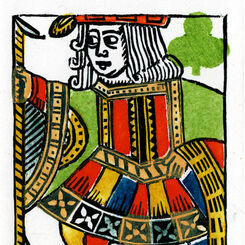
Woodblock and Stencil Jack of Clubs
A limited edition art print of the Jack of Clubs 1984 woodblock joker.
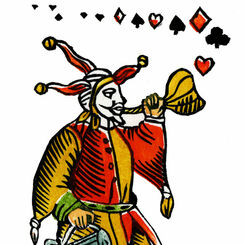
Woodblock and Stencil Joker
A limited edition art print of the 1984 woodblock joker.
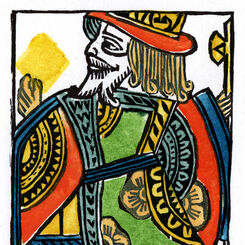
Woodblock and Stencil King of Diamonds
A limited edition art print of the King of Diamonds 1984 woodblock joker.
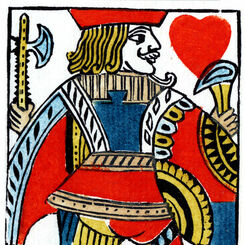
Woodblock and Stencil Jack of Hearts
A limited edition art print of the Jack of Hearts 1984 woodblock joker.
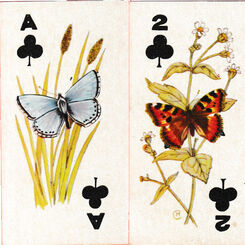
Sweetule Natural History cards
Small cards featuring natural history subjects, given away with packets of sweet cigarettes.
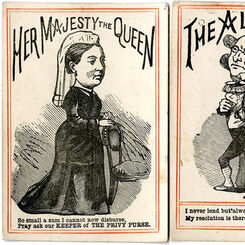
Lend Me Five Shillings
or “Her Majesty’s Privy Purse” - a merry round-the-table game published by D. Ogilvy.
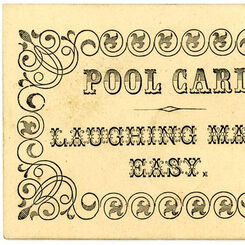
Laughing Made Easy
a Victorian card game published by D. Ogilvy.
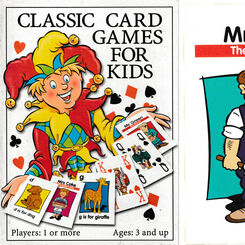
Classic Card Games for Kids
A boxed set of playing cards, Happy Families and an alphabet pack with rules for 22 games.
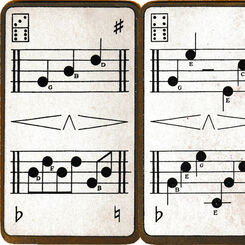
So-Lah – A Game of Music
An early 20th century domino-type musical card game by Goodall.
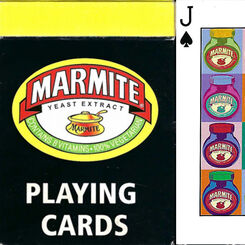
Marmite
Fifty-Four images celebrating a UK savoury spread, that has been around one hundred and twenty two y...
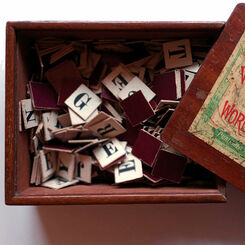
Word Making and Word Taking
How crossword and spelling games became popular.
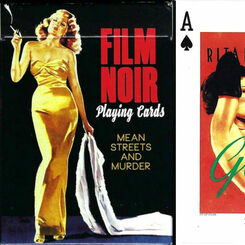
Film Noir
A deck of 55 cards, celebrating hard boiled heroes, wise-cracking women, mean streets, guns and gums...
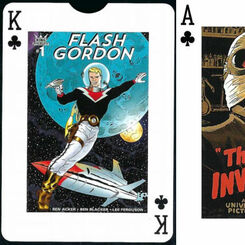
Science Fiction
A deck of 55 cards, celebrating a time when Science Fiction truly was, Science Fiction.
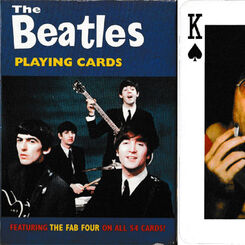
The Beatles playing cards
Two packs featuring photos of The Beatles issued by the same publisher in 2004 and 2005.
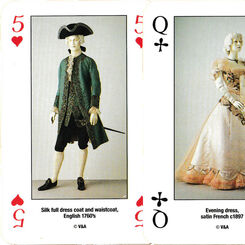
Costume Playing Cards
Four centuries of costumes from the Costume Court at the Victoria and Albert Museum.
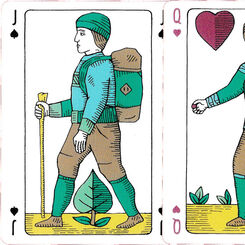
Commoners playing cards
Created by Ian Cumpstey dedicated to the common land and the countryside.
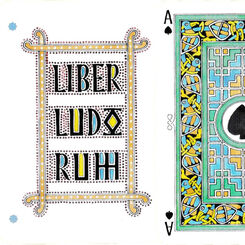
Liber Ludorum
Liber Ludorum playing cards created by Ian Cumpstey in the insular style, United Kingdom, 2019.
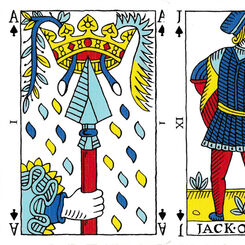
Pike and Clover playing cards
Pike and Clover playing cards created by Ian Cumpstey, Cumbria, UK, 2018.
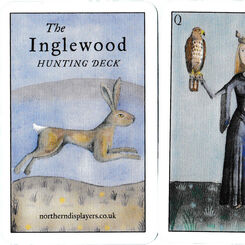
Inglewood Hunting Deck
Inglewood Hunting Deck created by Ian Cumpstey, United Kingdom, 2023.
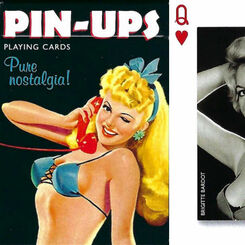
Pin-Ups
A deck of 55 cards celebrating a golden age of cheeky, naughty, bold and curvy ladies in film.
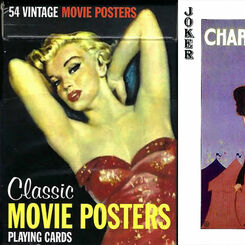
Classic Movie Posters
A deck of 55 cards presenting vintage classic movies and their stars.
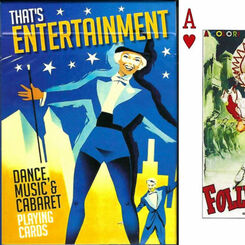
That’s Entertainment
A deck of 55 cards celebrating 20th Century vaudeville, musicals and cabaret.
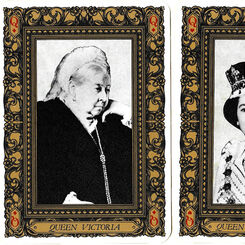
British Monarchs
Commemorating the royal wedding of Charles, Prince of Wales to Lady Diana Spencer on the 29th
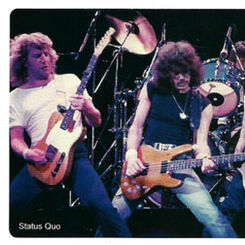
Rock & Pop Legends
Stunning photos of a selection of US and UK music artists.
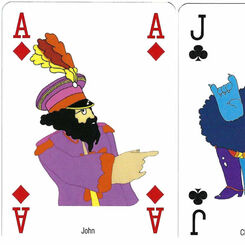
The Beatles • Yellow Submarine
A colourful deck celebrating the 1968 animated feature film based on the Lennon/McCartney song of th...
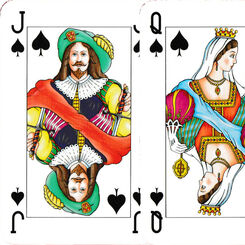
Dutch Court playing cards
Games & Print Services’ version of the Dutch pattern.
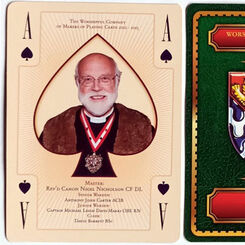
Past Masters’ Association Presentation Pack
The Worshipful Company of Makers of Playing Cards Past Masters’ Association Presentation Pack, 2013....
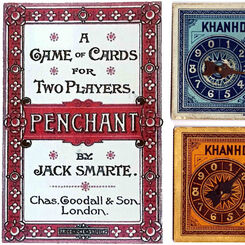
The Search for New Games in the late 19th century
A few new games survived and are still around today; most came and went and are only witnessed in th...
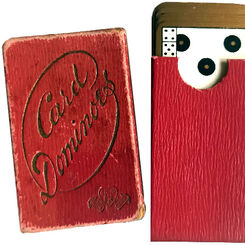
Miniature Card Dominoes
A miniature set of Goodall domino cards (5.9 x 3.5 cms) still in perfect condition.
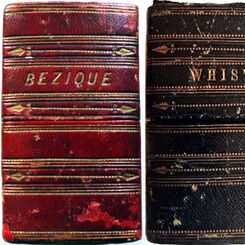
T. Drayton & Son
Bezique and Whist boxed sets by T. Drayton & Son, London, c.1875.
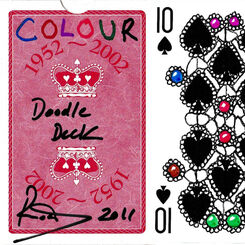
Colour doodle deck
“1952-2002 commemorative deck” customised with doodles by an uncredited artist, UK, 2011.
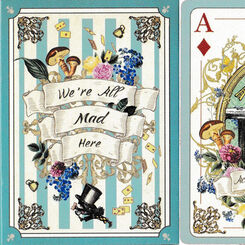
Alice in Wonderland: we’re all mad here
Alice in Wonderland themed playing cards, UK, 2020.
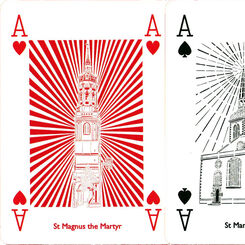
Wren 300 playing cards
Papercuts by Chloe Campbell of the 52 Wren churches in the City of London.
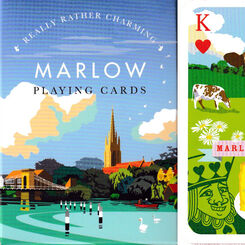
Marlow playing cards
Visitor attractions and businesses to be found in Marlow, Buckinghamshire.
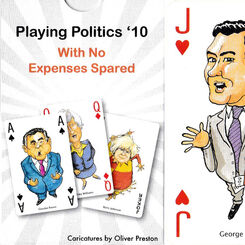
Playing Politics 2010
“Playing Politics ’10: With no expenses spared” featuring caricatures by Oliver Preston, published b...
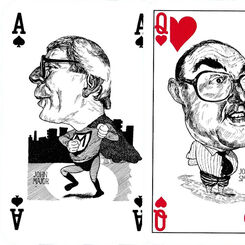
Playing Politics ’92: Pack of lies
Playing Politics ’92: Pack of lies with caricatures by Grant Robertson, UK.
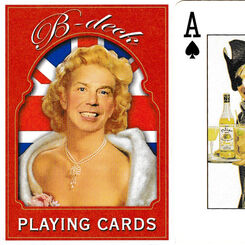
B-Deck
“B-Deck” scurrilous playing cards poking fun at a former UK prime minister.
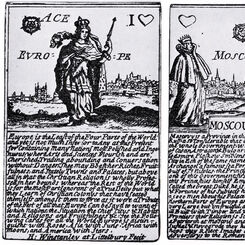
Winstanley Geographical cards
Facsimile of Winstanley’s Geographical cards produced by Harold & Virginia Wayland, 1967.
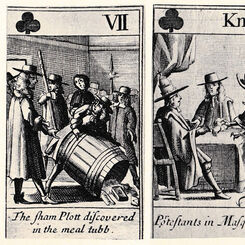
Meal Tub Plot
Meal Tub Plot playing cards [facsimile] with 17th century sketches by Francis Barlow.
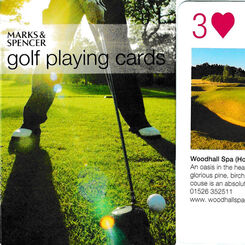
Golf playing cards
Golf playing cards published by Marks & Spencer, UK.
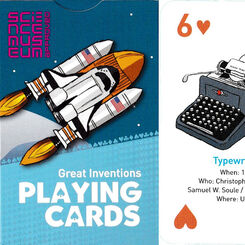
Great inventions playing cards
Great inventions playing cards designed by Gary Wyatt, United Kingdom, 2011.
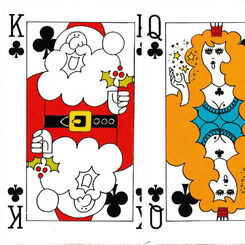
Christmas 1980 playing cards
Festive courts on a Waddingtons pack designed to celebrate Christmas 1980.
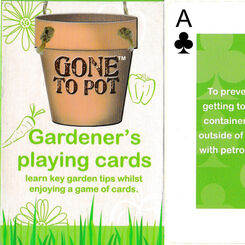
Gone to Pot: Gardener’s playing cards
‘Gone to Pot’: special playing cards for keen gardeners, United Kingdom.
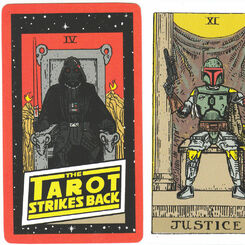
The Tarot Strikes Back
Roy Huteson Stewart's The Tarot Strikes Back combines Star Wars with Rider-Waite tarot imagery.


